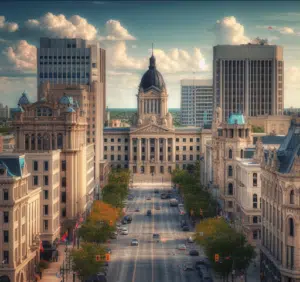Can HVAC Building Automation Systems Revitalise Old Buildings?

In a world increasingly focused on sustainability and smart technology, the role of HVAC building automation systems in breathing new life into old buildings is more critical than ever. These systems offer a unique blend of tradition and innovation, merging the timeless charm of historic structures with the efficiency of modern technology.
In this blog we’ll delve into:
1. Revitalising Historic Structures with HVAC Building Automation:
Discussing how HVAC building automation systems can transform and modernise older buildings while maintaining their historical integrity.
2. Enhancing Air Quality in Historic Buildings with HVAC Automation:
Examining how advanced HVAC systems upgrade air quality in older buildings, balancing modern efficiency with historical preservation.
3. Data-Driven Efficiency in Building Management:
Examining how the use of analytics in HVAC building automation systems leads to smarter energy management, predictive maintenance, and overall enhanced building performance.
Join us as we navigate the fascinating intersection of the old and the new, demonstrating how innovative HVAC solutions are reshaping the world of building automation and preservation. Whether you are a facility manager, a building owner, or simply someone intrigued by the harmonious blend of past and present, this exploration will illuminate the path towards a more efficient and sustainable future.
Revitalising Historic Structures with HVAC Building Automation
Historic buildings hold a unique place in our urban fabric, telling stories of the past while serving contemporary needs. However, many of these structures face challenges in terms of energy efficiency and modern functionality. This is where HVAC building automation systems come into play as a crucial tool for revitalization.
Embracing Modern Comfort in Time-Honoured Walls
Integrating HVAC building automation systems into older buildings is more than a technical upgrade; it's a step towards preserving history with a touch of modern comfort. These systems allow us to maintain the architectural integrity of historic buildings while ensuring they meet today’s standards for comfort and energy efficiency.
The Technical Transformation
HVAC building automation involves installing advanced control systems that manage heating, ventilation, and air conditioning in a more efficient and intelligent manner. For older buildings, this means custom solutions that respect structural limitations while introducing cutting-edge climate control.
Overcoming Challenges with Tailored Solutions
One of the primary challenges in retrofitting historic buildings with modern HVAC systems is the need for non-invasive installation techniques and equipment that can adapt to existing layouts. Building automation system companies specialise in providing tailored solutions that align with these unique requirements, ensuring that the installation process preserves the building’s historical essence.
The Outcome: A Blend of History and Efficiency
The result of integrating HVAC building automation systems in old buildings is a harmonious blend of historical charm and modern efficiency. This approach not only enhances the functionality and comfort of these spaces but also contributes to energy conservation and sustainability, ensuring these structures remain viable and vibrant parts of our communities for years to come.
In the next section, we'll delve deeper into how advanced HVAC building automation systems are not just improving air quality but also contributing to the overall energy management and performance of historic buildings, highlighting the synergy between technological advancement and preservation.
Enhancing Air Quality in Historic Buildings with HVAC Automation
Balancing Modern Efficiency with Historical Preservation
The quest to maintain the allure of historic buildings while meeting modern environmental standards presents a unique challenge, particularly when it comes to air quality. Advanced HVAC building automation systems are at the forefront of addressing this challenge, offering solutions that balance the need for preservation with the demands for modern efficiency.
The Role of HVAC in Preserving Indoor Air Quality
In many older buildings, the systems responsible for heating, ventilation, and air conditioning are outdated, leading to issues like poor air circulation, humidity problems, and inadequate filtration. Upgrading these systems with modern HVAC automation technologies allows for a significant improvement in indoor air quality. This not only enhances the comfort of the occupants but also helps in preserving the building's materials by controlling humidity and reducing the accumulation of potentially harmful substances.
Custom Solutions for Unique Structures
Each historic building comes with its own set of architectural idiosyncrasies and structural limitations. Implementing HVAC automation in such settings requires a customised approach. This involves designing systems that can be integrated seamlessly without disrupting the building's historical features. Advanced HVAC systems now come with options that are flexible, less invasive, and can be adapted to the unique needs of each building, ensuring that the historical integrity is not compromised.
The Impact of Improved Air Quality
By upgrading to advanced HVAC building automation systems, historic buildings benefit from enhanced air filtration, better humidity control, and more efficient overall air management. This leads to a healthier environment for occupants, protecting them from issues like mould, mildew, and other air quality-related health concerns. Furthermore, these improvements contribute to the longevity of the building itself, as better air quality means less deterioration of the structure over time.
The integration of modern HVAC automation systems into historic buildings represents a crucial step towards preserving these cultural treasures. It allows us to keep their historical essence intact while ensuring they are comfortable, healthy, and sustainable spaces for future generations. The next section will delve into how the use of analytics in HVAC building automation systems leads to smarter energy management and overall enhanced building performance.
Data-Driven Efficiency in Building Management
In the realm of HVAC building automation systems, especially in the context of historic buildings, the role of data-driven analytics is transformative. This section will explore how the integration of analytics into HVAC systems leads to smarter energy management, predictive maintenance, and overall enhanced performance of these systems.
Analytics: The Key to Optimised Energy Use
Analytics in HVAC systems provide deep insights into energy usage patterns, allowing for more informed decisions on energy management. By analysing data on temperature trends, occupancy patterns, and external weather conditions, these systems can optimise heating and cooling cycles, leading to significant energy savings and reduced operational costs.
Predictive Maintenance: A Proactive Approach
One of the standout benefits of incorporating analytics into HVAC systems is the ability to predict and prevent potential system failures before they occur. Predictive maintenance, powered by data analysis, can identify areas of concern in the system, allowing for timely interventions. This not only minimises downtime but also extends the life of the equipment, ensuring that the building's heating and cooling needs are consistently met without unexpected disruptions.
Enhancing Overall Building Performance
The use of analytics in HVAC systems is not limited to energy management and maintenance alone. It also plays a crucial role in improving the overall building performance. This includes maintaining optimal indoor air quality, ensuring consistent comfort levels for occupants, and adapting to changing environmental conditions with minimal manual intervention.
Challenges in Data Integration and Solutions
While the integration of analytics into HVAC systems in historic buildings offers numerous benefits, it also comes with its share of challenges. These include ensuring the compatibility of new technology with existing systems and managing the complexity of data analysis. However, with advances in technology and the expertise of building automation system companies, these challenges can be effectively managed.
The integration of analytics into HVAC building automation systems in historic buildings is more than just a technological upgrade; it's a strategic approach to building management. It enables these treasured structures to operate more efficiently, sustainably, and reliably, ensuring their viability and functionality for years to come. In our final section, we will conclude our exploration by summarising the overarching benefits of modernising historic buildings with advanced HVAC systems and the pivotal role of analytics in this transformation.
Conclusion
The integration of HVAC building automation systems in historic buildings is a crucial stride towards marrying heritage with efficiency. These systems, empowered by advanced analytics, not only preserve the architectural integrity of historic structures but also bring them into the modern age of energy efficiency and optimised indoor air quality.
This transformation, facilitated by sophisticated HVAC technologies, demonstrates how we can effectively balance historical preservation with the demands of contemporary building management. The use of data-driven analytics further enhances this balance, offering smarter energy management and predictive maintenance, thereby ensuring that these cherished buildings remain both functional and sustainable for future generations.
In an age where the past and future intersect, the role of building automation system companies becomes pivotal. Their expertise in customising solutions for unique historic buildings plays a key role in this seamless integration of old and new.
For those looking to embrace this blend of tradition and technology, Tri-Star Automation stands ready to guide and implement cutting-edge HVAC automation solutions, ensuring your historic buildings are not just preserved but revitalised for the future.


